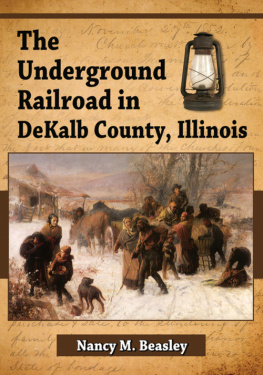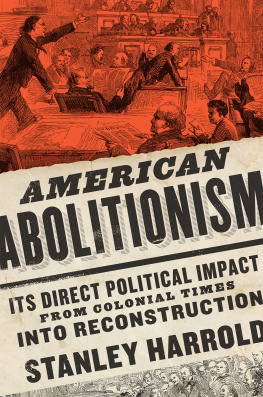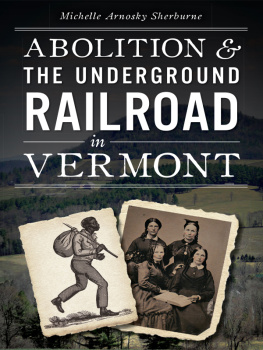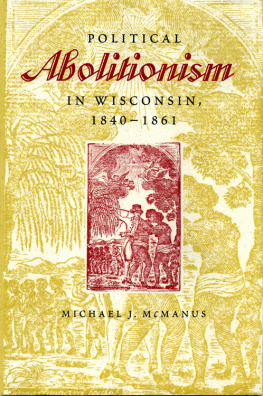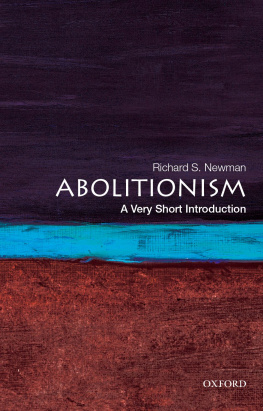Acknowledgments
This book was a joy to research and write in part because of all the wonderful friends, colleagues, librarians, archivists, and students who have provided assistance, support, encouragement, and advice. I apologize if I neglect anyone among the dozens of people who contributed in one way or another to this project over the past decade.
I thank the helpful staff at the Boston Public Library Rare Books Department, the Chicago Historical Society, the Cincinnati Historical Society Library, the Cincinnati Public Library, the Earlham College Library, the Historical Society of Pennsylvania, the Illinois State Historical Library, the Illinois State University Special Collections Department, the Indiana Historical Library, the Indiana State Library, the Kent State University Library, the Knox College Library, the Library Company of Philadelphia, the Massachusetts Historical Society, the Ohio Historical Society, Swarthmore College's Friends Historical Library, the Western Reserve Historical Society, and the Wheaton College Library. I am especially grateful to the institutions that granted me fellowships to conduct research. I spent a week at Oberlin College thanks to Roland Bauman and the Frederick B. Artz Summer Research Grant. Bill Wallach and the Bentley Historical Society offered me the Bordin/Gillette Research Fellowship that enabled me to devote a month to research in Ann Arbor. I spent another delightful and productive month on fellowship at the American Antiquarian Society under the expert guidance of Gigi Barnhill, Joanne Chaison, Paul Erickson, and Caroline Sloat. I also spent a month on fellowship at the Gilder Lehrman Center for the Study of Slavery, Resistance, and Abolition. Dana Schaffer, Melissa McGrath, and David Blight were invaluable in introducing me to the extraordinary resources at Yale University. I also thank my home institution, Bradley University, for two summer research fellowships. Dean Claire Etaugh provided funds that permitted me to attend conferences and conduct research, and I cannot fully express my appreciation for this support. Her friendship and mentorship are even more priceless.
The University of North Carolina Press has been an excellent and professional institution, and I am proud to have my book published by this press. My kindest regards go to Chuck Grench, Katy O'Brien, Paula Wald, and all the other superb staff who have helped transform this manuscript into a book. I am especially indebted to copyeditor Ellen D. Goldlust-Gingrich for her excellent eye and stylistic skill.
I am indebted to all those colleagues and friends who shared ideas with me, read parts of the manuscript, and enriched our shared scholarly community. My Illinois colleagues include Bill Furry, Pat Goitein, Richard John, Channy Lyons, Bob McColley, Bill and Jane Ann Moore, Owen Muelder, and Junius Rodriguez. I am especially pleased to thank my Women's Historians at Middle Illinois Group: Tina Brakebill, Kyle Ciani, Stacy Cordery, Sandra Harmon, Mary Johnson, Karen Leroux, Deborah McGregor, and April Schultz. We've been reading each other's work, encouraging one another, and breaking bread together for nearly a decade. My fellow scholars of the antislavery movement have been a true inspiration over the years: Carol Faulkner, Julie Roy Jeffrey, Michael Pierson, Beth Salerno, Deborah Bingham Van Broekhoven, and Dana Weiner. What would I do without my longtime conference buddies? Thank you dear friends: Ann Boylan, Jim Broussard, Elizabeth Clapp, Chris Clark, Hugh Davis, Dan Dupre, Doug Egerton, Dan Feller, Craig Friend, Craig Hammond, Graham Hodges, Gary Kornblith, Albrecht Koschnik, Scott Martin, Matt Mason, Monique Patenaude, John Quist, Don Ratcliffe, Kyle Roberts, Jonathan Sassi, Mitchell Snay, and Tamara Thornton. I am equally thankful for the aid of independent scholars Kathy Ernst and Judith Harper.
A few people have generously read all (or nearly all) of the manuscript and offered inestimable advice. I am deeply indebted to the anonymous reviewer as well as to Richard Blackett, Stacy Cordery, Stan Harrold, Carol Lasser, and Jim Stewart. Several friends deserve more thanks than I can offer here. Jim Stewart is the best role model, friend, and mentor anyone could ask for. His bighearted spirit and brilliance are truly unmatched. In particular, I will never forget our shared drink in Philadelphia and the advice he gave me about priorities and balance. Stan Harrold pulled no punches in his critique of my work even as he gave me unqualified encouragement and memorable moments at conferences over the years. His friendship is deeply important to me. Pat Cohen has been a source of scholarly and personal inspiration for more than twenty years. She spent countless hours helping me track obscure characters and is the embodiment of munificence. Carol Lasser is my scholarly sister and dear friend. No one has offered more words of uplift and intellectual inspiration.
My community of scholars and friends at Bradley University and in Peoria is boundlessly supportive. I extend earnest gratitude to Patricia Benassi, Rob Faber, Heather Fowler-Salamini, Bob Fuller, Rusty Gates, Emily Gill, Sarah Glover, Greg Guzman, Jackie Hogan, Phil Jones, Barb and Seth Katz, Randy Kidd, Maggie Koehler, Gina Meeks, Amy Scott, Susan Smith, Ryan Stevenson, and Aurea Toxqui. I am happy to offer my appreciation to Bradley president Joanne Glasser for her inspired leadership and the generous friendship she has offered me. I'm not sure what I would have done without the amazing Pat Campbell, who has been a dear friend since I arrived in Peoria. Thanks also go to my friends who have moved on to other institutions: Kerry Ferris, Issam Nassar and Adriana Ponce, and Marjorie Worthington. I give a special shout out to the Blue Scarf Society, Dawn Roberts and Chris Blouch, who have stood with me through good times and bad. I'm not sure that I could have remained sane without my 5:30 A.M. Jazzercise class. Thanks to my fellow predawn exercisers for making it worth the effort, especially on those cold Illinois winter mornings.


